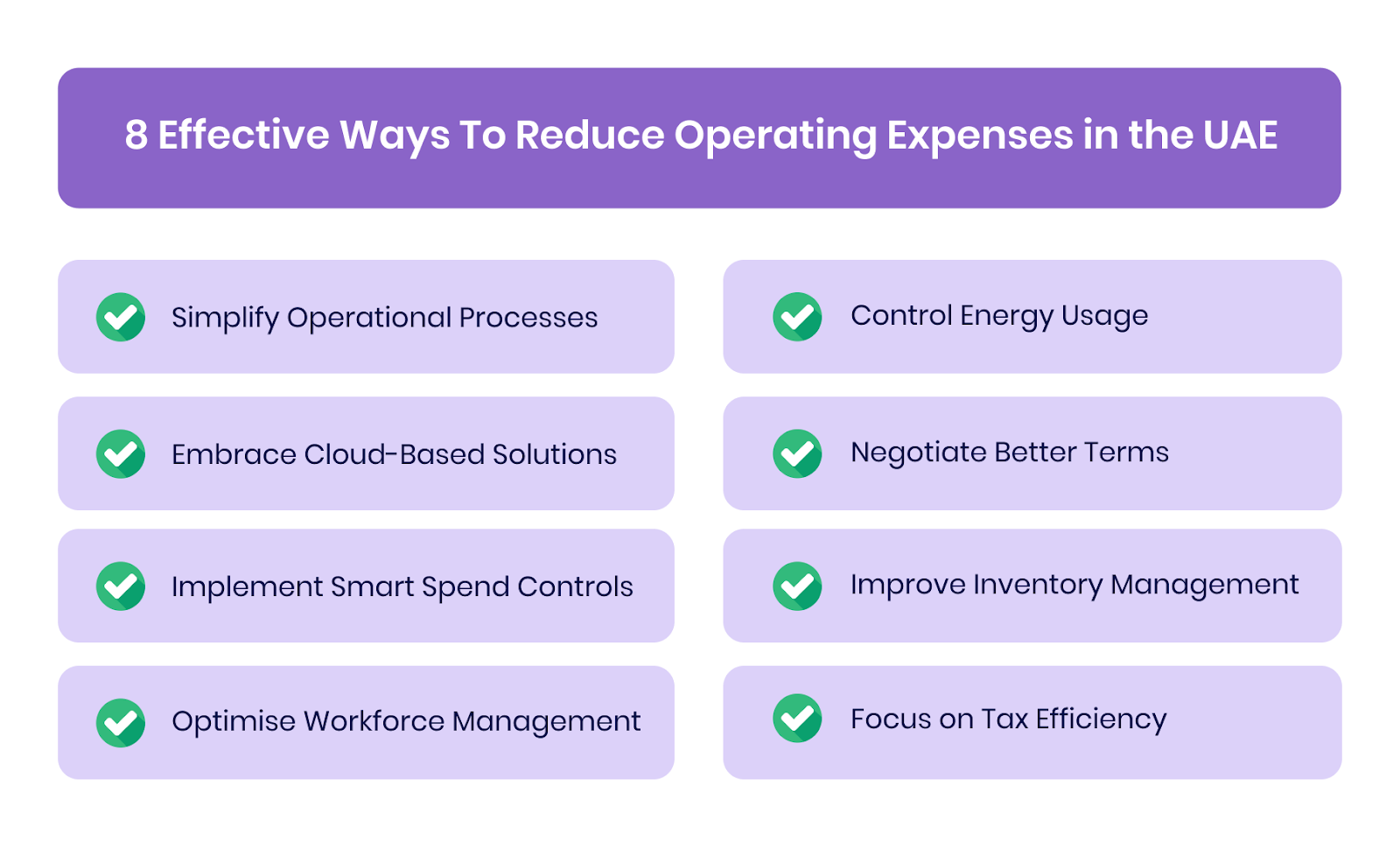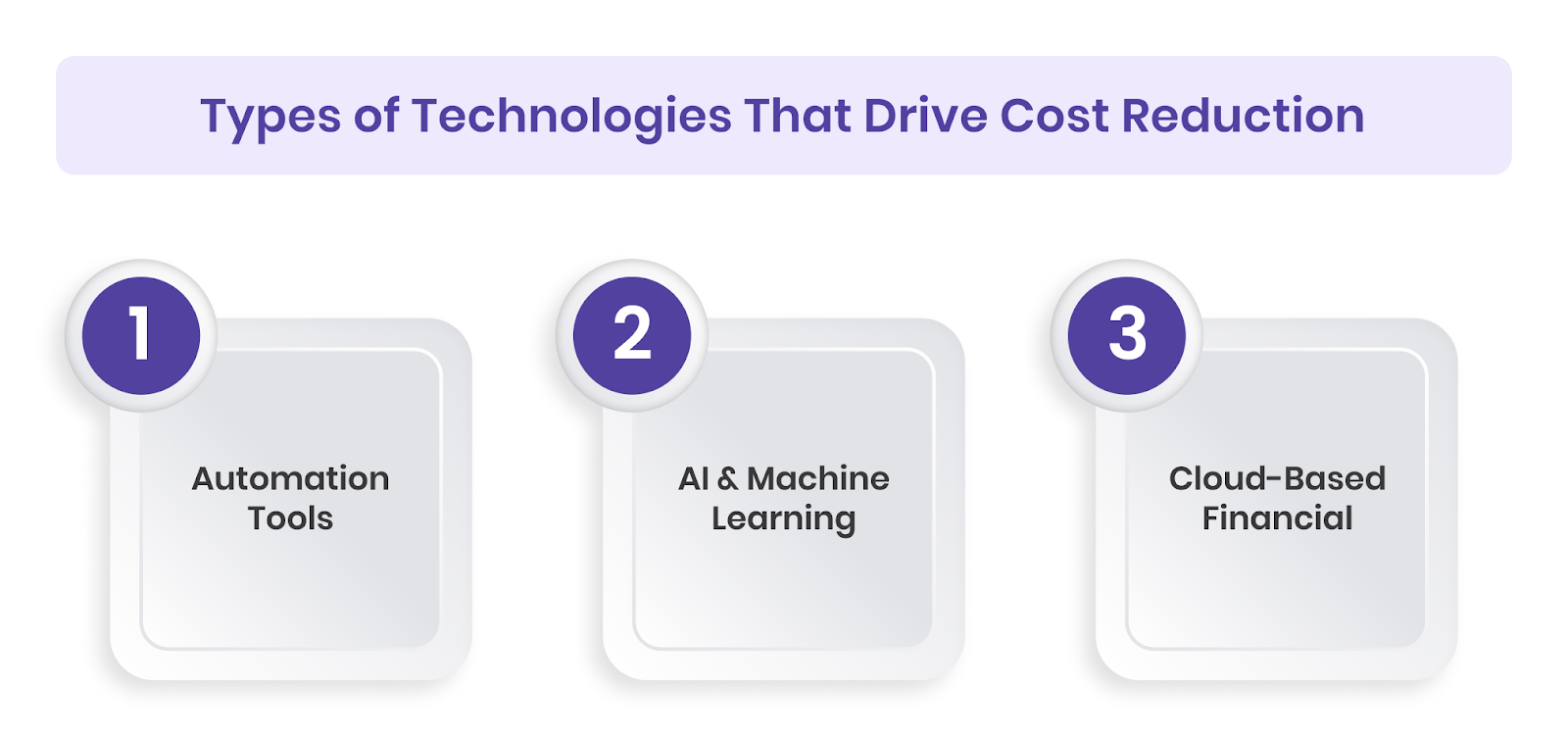Rising operational costs are a challenge many businesses in the UAE deal with, but they don’t have to slow down growth. Day-to-day costs like utilities and labour can add up fast, reducing profits and slowing innovation.
In fact, the UAE’s non-oil trade reached nearly 3 trillion dirhams in 2024, and as a result, businesses are under increasing pressure to stay competitive by keeping costs under control. The positive side is that there are practical ways to manage these costs without compromising on quality or productivity.
In this article, you will look at the smart and effective ways to reduce operating expenses to simplify operations, secure better deals, and make the most of your resources.
Key Takeaways
- Reducing operating expenses in the UAE requires a focus on process optimisation, cloud adoption, and workforce management to drive profitability and growth.
- Cloud-based solutions lower IT costs and improve efficiency, while automation simplifies workflows and reduces errors.
- Negotiating better vendor terms and optimising inventory management can create immediate savings without compromising quality.
- Technology like AI-driven analytics and automated reporting enhances operations and keeps businesses competitive.
- Adhering to VAT rules and local regulations avoids penalties, while smart tax strategies ensure sustainable cost reduction.
What are Operating Expenses?
Operating expenses are the everyday costs a business faces to keep things running smoothly. They cover the regular expenses of running a business, but don’t include the cost of goods sold (COGS) or big investments like capital expenditures (CAPEX).
Typical operating expenses include rent, utilities, employee salaries, marketing, insurance, and administrative costs. These are essential for day-to-day operations and are recorded on the income statement, helping businesses keep track of their profitability.
Once you understand what operating expenses include, it becomes easier to identify ways to manage and reduce them effectively.
8 Effective Ways To Reduce Operating Expenses in the UAE

Operating expenses can quickly become a major challenge for businesses in the UAE. So, managing these expenses efficiently is crucial for maintaining profitability and for sustaining growth in a competitive market.
Here are eight practical ways to help businesses cut costs without affecting quality or growth.
1. Simplify Operational Processes
Operational inefficiencies are often hidden drivers of high expenses. By simplifying internal processes, removing redundancies, and automating repetitive tasks, businesses can free up valuable resources and reduce overhead.
To reduce operating expenses:
- Identify Bottlenecks: Conduct a process audit to pinpoint inefficiencies in areas like approval workflows, communication, or procurement. Gather employee feedback and map out each workflow step.
- Automate Repetitive Tasks: Implement automation for routine tasks such as data entry, expense tracking, and invoice processing. This reduces errors, improves accuracy, and frees employees for higher-value work.
- Optimise Resource Allocation: Reassign resources to critical tasks and ensure employees’ time is spent efficiently. Encourage cross-training to prevent bottlenecks when key staff are unavailable.
- Regularly Review Processes: Periodically review workflows to ensure efficiency as business needs evolve, incorporating new technologies or industry best practices.
Also Read: 8 Steps for Effective Employee Expense Management in the UAE
2. Embrace Cloud-Based Solutions
Traditional on-premise IT solutions come with high maintenance costs, hardware investments, and long-term commitments. Cloud-based solutions offer flexibility, scalability, and cost-effectiveness, helping reduce overall IT expenditure.
To reduce operating expenses:
- Move to the Cloud: Migrate essential functions, such as data storage, CRM, and accounting, to cloud-based platforms. This eliminates costly hardware and maintenance.
- Adopt SaaS Solutions: Use subscription-based software-as-a-service tools for lower upfront costs and scalable solutions.
- Consolidate Systems: Choose integrated cloud solutions that manage multiple functions to reduce licensing fees and simplify support.
- Monitor and Optimise Usage: Track cloud resource usage and adjust based on demand, scaling down during low-usage periods to save costs.
3. Implement Smart Spend Controls
Monitoring expenses in real time ensures that spending aligns with company policies and budgets. A strong system for managing expenses helps prevent unnecessary outflows.
To reduce operating expenses:
- Set Clear Budget Limits: Define spending limits for departments and projects, and ensure employees understand the consequences of exceeding them.
- Track Expenses in Real Time: Use tools to monitor expenses continuously and detect discrepancies early.
- Enforce Vendor Restrictions: Limit purchases to pre-approved vendors or negotiate long-term contracts to secure better rates.
- Review and Approve Expenses Promptly: Establish workflows to review all expenses before processing, preventing unauthorised purchases.
4. Optimise Workforce Management
Labour costs often form the largest portion of operating expenses. Optimising workforce management can reduce costs while maintaining productivity. To reduce operating expenses:
- Outsource Non-Core Activities: Delegate non-essential functions like IT support, customer service, or marketing to third-party providers.
- Implement Flexible Working Arrangements: Promote remote or hybrid work models to lower office space and utility costs while improving employee morale.
- Cross-Train Employees: Equip staff to perform multiple roles, reducing the need for additional hires and ensuring operational continuity.
- Use Freelancers for Short-Term Needs: Hire freelancers or contractors for seasonal or short-term projects to scale the workforce without long-term commitments.
5. Control Energy Usage and Reduce Utility Bills
Energy costs, particularly in the UAE’s hotter months, can be significant. Adopting energy-efficient practices leads to substantial savings. To reduce operating expenses:
- Invest in Energy-Efficient Equipment: Replace outdated equipment with LED lighting, energy-efficient HVAC systems, and smart thermostats.
- Use Energy Management Systems: Install smart metres to track and control energy usage in real time.
- Switch to Renewable Energy: Explore solar panels or other renewable energy options to reduce dependence on traditional energy sources.
- Encourage Energy-Conscious Practices: Educate employees on turning off lights and devices when not in use and adopting policies to reduce unnecessary consumption.
6. Negotiate Better Terms with Service Providers
Contracts with suppliers and service providers can significantly affect operating expenses. Regular reviews and negotiations can lower costs and add value. To reduce operating expenses:
- Review Contracts Regularly: Assess contracts for telecom, office supplies, insurance, and other recurring expenses to identify renegotiation opportunities.
- Use Long-Term Relationships: Build strong ties with key suppliers for better pricing and preferential terms.
- Shop Around for Better Rates: Compare offers regularly to ensure competitive pricing, especially for utilities, internet, and insurance.
- Bundle Services: Combine multiple services with a single provider to secure discounts.
7. Improve Inventory Management and Reduce Wastage
Inefficient inventory management leads to overstocking, storage costs, and waste. Optimising inventory ensures businesses purchase only what is needed. To reduce operating expenses:
- Implement Just-in-Time (JIT) Inventory: Order stock only when necessary to reduce holding costs and prevent overstocking.
- Use Automated Inventory Management Systems: Invest in software for real-time inventory tracking to avoid over-ordering.
- Regularly Audit Inventory: Conduct audits to identify expired or obsolete stock for disposal or return.
- Negotiate Bulk Discounts Carefully: Purchase in bulk to save costs, but avoid excessive stock that becomes a liability.
8. Focus on Tax Efficiency and VAT Compliance
VAT compliance is mandatory in the UAE, but optimising tax strategies can reduce expenses. For that:
- Maintain Accurate VAT Records: Track all transactions carefully to maximise VAT recovery.
- Consult Tax Experts: Use deductions, incentives, and exemptions with professional advice.
- Automate VAT Compliance: Use systems to submit VAT returns on time and reduce errors.
- Regularly Review Tax Liabilities: Ensure correct payments and avoid overpaying.
After exploring practical cost-saving methods, the next step is knowing which areas to prioritise for the greatest impact.
How to Identify and Prioritise Cost-Cutting Initiatives?
While reducing costs is important, the focus should be on areas that deliver meaningful, long-term benefits. Cutting without proper analysis can backfire, leading to reduced efficiency, growth, or low employee morale.
To avoid these pitfalls, businesses need a structured approach to identifying and prioritising initiatives that truly make a difference. Here’s how to identify and prioritise cost-cutting initiatives:
1. Conduct a Thorough Expense Audit
Before cutting costs, businesses need a clear picture of where money is going. A detailed expense audit provides the insights needed to identify inefficiencies and areas of excessive spending.
To conduct an expense audit:
- Review Financial Statements: Analyse profit and loss, balance sheet, and cash flow reports to identify spending patterns across categories like rent, salaries, utilities, and supplier payments.
- Track All Outflows: Record every expense, including smaller recurring payments that often go unnoticed but add up over time. Expense management software can help categorise spending and flag unusual costs.
- Compare Industry Benchmarks: Measure your expenses against industry averages or competitors to highlight areas where your business may be overspending.
2. Categorise Your Expenses
Not all expenses are the same, and different categories require different approaches. Breaking down costs makes it easier to target reductions effectively.
Key categories to consider here include:
- Fixed vs. Variable Costs: Fixed costs (rent, salaries, insurance) remain constant, while variable costs (utilities, raw materials, commissions) fluctuate with activity. Variable costs often offer more flexibility for reduction.
- Essential vs. Non-Essential Costs: Identify expenses critical to operations (salaries, inventory) versus discretionary ones (office décor, non-essential marketing campaigns). Non-essential costs are usually easier to trim.
- Short-Term vs. Long-Term Investments: Distinguish between one-time investments (technology upgrades) and ongoing operational costs. Focus first on recurring expenses for sustainable savings.
Also Read: Small Business Expense Reimbursement Policy Best Practices
3. Identify High-Cost Areas
Once expenses are categorised, attention should shift to areas with the biggest financial impact. These are usually where the most substantial savings can be made without disrupting core operations.
To identify high-cost areas:
- Focus on Large, Recurring Expenses: Examine major expenses such as office rent, utilities, salaries, or supplier contracts for opportunities to save.
- Review Overhead and Administrative Costs: Look into office supplies, software licences, or administrative services that may be excessive or duplicative.
- Assess Supply Chain Inefficiencies: Investigate procurement and logistics for unnecessary costs, such as high shipping fees or inventory waste.
4. Evaluate the Impact of Cost-Cutting on Operations
Not all cost reductions are beneficial. Each initiative should be assessed for its effect on operations, growth, and long-term sustainability.
Key considerations for evaluating impact:
- Avoid Cutting Critical Functions: Ensure essential areas like product quality, customer service, or compliance aren’t compromised. Poor decisions here can harm reputation and customer loyalty.
- Maintain Employee Morale: Salary or benefit cuts may lower costs, but often lead to disengagement and higher turnover. Explore alternatives like flexible work arrangements or cross-training instead.
- Stay Compliant: In the UAE, compliance with VAT, labour laws, and licensing requirements is non-negotiable. Cutting compliance-related expenses could result in heavy penalties and reputational damage.
5. Prioritise Initiatives Based on ROI and Business Impact
After identifying the potential opportunities, businesses should rank them by return on investment (ROI) and overall impact. This ensures the most valuable initiatives are acted on first.
To prioritise initiatives:
- Evaluate ROI: Estimate potential savings versus the costs and effort of implementation. For example, renegotiating supplier contracts may require time but can lead to significant long-term gains.
- Balance Short-Term and Long-Term Savings: Implement measures that deliver quick results without undermining future growth. Cutting back on employee training may save money now, but it will limit competitiveness later.
- Weigh Risks and Rewards: Consider how cost reductions could affect market share, customer satisfaction, or competitive positioning before making a decision.
6. Implement and Monitor Progress
Even the best cost-cutting strategy fails without proper execution and tracking. Effective implementation ensures savings are realised and sustained over time.
For successful implementation:
- Set Clear Goals and Metrics: Define measurable objectives, such as reducing energy costs by 10% or lowering office supply expenses by 20%.
- Track Progress Regularly: Conduct regular reviews to check whether initiatives are delivering the expected savings. Adjust strategies if needed.
- Engage Employees: Communicate the reasons for cost-cutting and involve staff in the process. Employee buy-in improves success rates and surfaces new opportunities for savings.
Once the key areas are identified, technology can play a crucial role in simplifying processes and driving further cost efficiency.
Assessing Technology and Its Role in Cost Reduction
The first step in using technology for cost reduction is to pinpoint the parts of your business that are burdened by inefficiencies, manual processes, or outdated systems. These are often the areas where savings can be realised most effectively:
- Administrative and Repetitive Tasks: Processes like data entry, expense tracking, invoice processing, and payroll are time-consuming and prone to human error. Automating these tasks helps reduce mistakes, speed up workflows, and free up employee time for more value-driven activities.
- Communication and Collaboration: Relying on traditional tools such as phone calls, faxes, or lengthy email chains can slow down operations. Cloud-based communication and collaboration platforms simplify workflows, improve productivity, and reduce operational delays.
- Inventory and Supply Chain Management: Manual inventory tracking often leads to errors and excess costs. Modern tools such as inventory management software and integrated supply chain solutions enable businesses to monitor stock in real time, optimise order levels, and cut wastage, all contributing to direct cost savings.
Once you understand the role of technology, it’s worth looking at specific tools and systems that can help cut costs.
Types of Technologies That Drive Cost Reduction

After identifying areas where technology can make a difference, the next step is to explore the tools that can directly reduce costs. Below are some of the most effective technologies businesses are adopting to lower operating expenses.
1. Automation Tools
Automating routine processes such as accounting, invoicing, and payroll eliminates repetitive manual work. This reduces the risk of errors and improves efficiency by allowing teams to focus on higher-value activities. For example, Robotic Process Automation (RPA), AI-powered expense management platforms, and automated marketing workflows.
2. AI and Machine Learning
AI and machine learning help businesses make smarter, data-driven decisions. From predicting demand to optimising inventory and enhancing customer interactions, these technologies bring intelligence to everyday operations. They include predictive analytics, AI chatbots for customer service, and intelligent supply chain management systems.
3. Cloud-Based Financial and ERP Systems
Integrated financial and ERP systems simplify complex workflows by centralising processes such as budgeting, reporting, invoicing, and procurement. With real-time visibility, businesses can better control costs and improve accuracy. This includes ERP platforms for financial management, inventory tracking, and procurement.
These technologies offer many benefits, but it’s important to be aware of common pitfalls that can reduce their effectiveness.
Common Mistakes to Avoid When Reducing Operating Expenses
While cutting operating expenses is key to improving profitability, the process requires careful planning. Many businesses are in a rush to save money, and they end up making decisions that harm long-term growth and competitiveness.
To avoid these pitfalls, understand the most common mistakes companies make when reducing costs.
Avoiding mistakes also means ensuring compliance, as legal and regulatory requirements can affect cost management strategies.
Legal and Regulatory Considerations in the UAE
Operating a business in the UAE means working within a clear legal and regulatory framework. These rules directly affect operating costs, and understanding them helps avoid penalties, reduce risks, and keep expenses under control. Below are the legal and regulatory considerations in the UAE.
VAT Compliance and Its Financial Impact
Value Added Tax (VAT), introduced in 2018, changed how businesses in the UAE manage their finances. While VAT is a pass-through tax collected from customers and paid to the government, it still adds complexity to business operations.
Key points to keep in mind:
- VAT Registration: Companies with taxable supplies above AED 375,000 must register with the Federal Tax Authority (FTA). Registration itself and ongoing compliance require time and administrative effort.
- Tax Invoices: Businesses need to issue VAT-compliant invoices for every transaction, which means investing in proper billing systems and training.
- VAT Filing: Returns must be submitted regularly, and delays can lead to hefty fines.
- Input VAT Recovery: Businesses can recover VAT on certain expenses, but this requires careful record-keeping and compliance with regulations.
Licencing and Business Registration Costs
Getting the right licences is one of the first and most important steps to operate legally in the UAE. The type of licence, location, and business structure directly affect costs.
Key points to consider:
- Type of Licence: Whether commercial, industrial, or professional, each comes with its own fees and requirements.
- Free Zone vs. Mainland: Free zones often offer lower setup costs and simpler processes, while mainland companies may face higher compliance expenses.
- Renewals: Licences typically need yearly renewal, which involves administrative fees and sometimes inspections.
Labour Laws and Employee Costs
Hiring employees in the UAE comes with responsibilities defined by labour laws. These ensure fair treatment of workers but also add to operational costs.
Important areas to note:
- Salaries and Benefits: Employers must provide health insurance, paid leave, and end-of-service gratuity, in addition to salaries.
- Contracts: Written contracts are mandatory, and failure to comply can lead to penalties.
- End-of-Service Gratuity: Payments depend on an employee’s service length and must be factored into financial planning.
- Worker Protection Laws: In certain sectors, businesses must provide safe conditions, proper accommodation, and transport, adding to overall expenses.
Health and Safety Regulations
Workplace safety is a legal requirement in the UAE, especially in high-risk industries like construction and manufacturing. Compliance ensures worker well-being but also requires investment.
Key areas include:
- Safety Standards: Businesses may need to invest in equipment, training, and regular inspections.
- Insurance: High-risk industries must provide workers’ compensation and liability insurance, which can be costly.
- Audits: Regular compliance checks can add costs, and non-compliance leads to fines.
Data Privacy and Cybersecurity Laws
As digital adoption grows, the UAE has strengthened its laws around data protection. Businesses must safeguard customer and employee information to avoid legal and financial consequences.
Key requirements include:
- Data Protection Law: Companies must adopt secure data storage, encryption, and privacy policies.
- Cybersecurity Investments: Secure IT infrastructure, audits, and staff training are essential.
- Compliance Audits: Regular checks may involve external consultants and additional costs.
Environmental Regulations
Sustainability is now a major focus in the UAE, and businesses are expected to comply with environmental laws. While this may require investment, it often leads to long-term savings. This involves:
- Waste Management: Companies in industries like manufacturing and hospitality must follow strict disposal and recycling guidelines.
- Energy Efficiency: Businesses are encouraged to adopt renewable energy, efficient equipment, and sustainable designs. These may add upfront costs but reduce operating expenses over time.
Beyond compliance, there are additional approaches and best practices that businesses can adopt to further optimise expenses.
Additional Strategies for Cost Reduction
While simplifying processes and automating tasks are proven ways to reduce operating costs, UAE businesses take it a step further by adopting additional strategies that create long-term savings. Below are some effective strategies for cost reduction:
1. Use Digital Marketing for Cost-Effective Advertising
Digital marketing offers a more affordable and targeted approach, often delivering a higher return on investment (ROI). To keep marketing costs low:
- Use Social Media Platforms: Platforms like Instagram, LinkedIn, and Facebook let you target specific demographics and track performance, ensuring your budget is spent wisely.
- Focus on Content Marketing: Blogs, videos, and infographics can help attract customers organically, reducing reliance on paid ads.
- Optimise for SEO: A well-optimised website brings long-term, free traffic and lowers customer acquisition costs.
- Run Email Campaigns: Regular email campaigns are a cost-effective way to build relationships and promote products or services.
2. Focus on Data-Driven Decision Making
Data is one of the most powerful tools for controlling costs. By analysing business performance, companies can identify inefficiencies and allocate resources more effectively. To put data to work:
- Use BI Tools: Tools like Power BI or Tableau provide real-time insights into operations, helping spot cost-saving opportunities.
- Track KPIs: Monitoring key metrics across sales, inventory, and customer service highlights areas where costs can be trimmed.
- Adopt Predictive Analytics: Forecasting demand and expenses helps avoid overspending on stock or resources.
3. Review and Optimise Supply Chain Management
An inefficient supply chain often means higher costs in storage, shipping, and procurement. Regular reviews can help simplify operations and reduce unnecessary spending. To improve supply chain efficiency:
- Negotiate Supplier Terms: Long-term relationships with suppliers often lead to better pricing and payment terms.
- Adopt Just-in-Time Inventory: Purchasing goods only when needed lowers holding costs and reduces waste.
- Consolidate Shipments: Grouping shipments reduces freight charges, especially for import-heavy businesses.
- Use Supply Chain Software: Real-time tracking of stock and deliveries minimises delays and reduces waste.
4. Automate Financial Reporting and Reconciliation
Manual financial processes are time-consuming and also prone to errors. Automation reduces these risks while cutting labour costs. To simplify finance functions:
- Invest in Accounting Software: Platforms like Xero, QuickBooks, or NetSuite simplify bookkeeping and reporting.
- Automate Reconciliation: Matching bank transactions automatically saves time and reduces mistakes.
- Automate Tax Filing: Integrated tools can handle VAT and tax submissions, reducing compliance headaches.
How Alaan Can Help Reduce Operating Expenses?
At Alaan, we understand that controlling operating expenses is crucial for long-term success. Our AI-powered platform is designed to help businesses in the UAE optimise their spending and simplify operations. Here’s how our features can help you reduce costs and improve financial efficiency:
- Smart Spend Controls: One of the most effective ways to reduce operating expenses is by keeping spending in check. With Alaan's smart spend controls, you can set customised limits on spending for different departments, projects, or individual purchases to ensure costs stay within budget.
- Automated Expense Categorisation: Manual expense tracking can be time-consuming and prone to errors. Alaan automates the categorisation of expenses, ensuring every transaction is accurately recorded and classified. This reduces administrative overhead and ensures financial transparency.
- Real-Time Spend Visibility: By providing real-time visibility into all your business expenses, Alaan allows you to monitor spending as it happens. This instant access enables you to identify discrepancies, optimise spending, and make informed decisions to reduce unnecessary costs.
- Smooth Accounting Integration: Alaan's one-click accounting integration eliminates manual data entry, saving valuable time and reducing the risk of errors. This simplifies the financial process, ensuring your books are always up-to-date and ready for reporting, audits, or tax filings.
- Automated VAT Compliance: Staying compliant with VAT regulations is critical in the UAE. Alaan automates VAT categorisation and tax calculations, helping businesses manage VAT efficiently while reducing the risk of penalties and ensuring tax savings.
- Full Transparency and Control: Alaan’s platform provides full transparency across your entire business spend. With real-time updates and detailed reports, you can easily track where your money is going, identify areas for savings, and gain better control over your operating expenses.
With Alaan, reducing operating expenses becomes smooth, helping you optimise resources, maintain cash flow, and scale your business effectively.
Wrapping Up
Reducing operating expenses is essential for businesses that want to stay competitive. By simplifying processes, adopting the right technology, and using resources wisely, companies can cut costs without holding back growth or quality.
At Alaan, we understand the importance of controlling expenses and offer smart, AI-powered solutions for businesses to optimise spending and simplify operations.
Our platform empowers businesses with real-time spend visibility, smooth integrations, and automated expense management, helping you make data-driven decisions and achieve long-term financial success.
Book a quick demo today and discover how Alaan can simplify your expense management and boost your profitability without adding extra complexity.
FAQs
1. Why is vendor negotiation important for reducing expenses?
Negotiating better rates and long-term contracts with suppliers can help businesses cut procurement costs significantly. Regularly reviewing supplier agreements ensures you’re not paying more than necessary for goods and services.
2. How does negotiating better payment terms with suppliers reduce costs?
Longer payment terms give businesses more flexibility with cash flow, allowing them to pay for purchases later without extra interest. This helps optimise liquidity and reduces the need for short-term borrowing.
3. What is the impact of tax planning on operating expenses?
Good tax planning helps businesses make the most of deductions, credits, and exemptions, lowering overall tax bills. Working with tax experts allows companies to manage taxes more efficiently, freeing up funds for other investments.
4. How can technology reduce transportation and logistics costs?
Modern logistics software can plan smarter delivery routes, saving fuel and time. Inventory and shipment tracking tools also help businesses manage operations more efficiently, cutting overall transportation costs.
5. How can businesses manage legal and compliance costs effectively?
Being proactive about legal compliance and staying updated on regulations helps prevent fines and unexpected costs. Using legal software and simplifying contract management can also reduce expenses linked to legal services.


.avif)






%201.png)